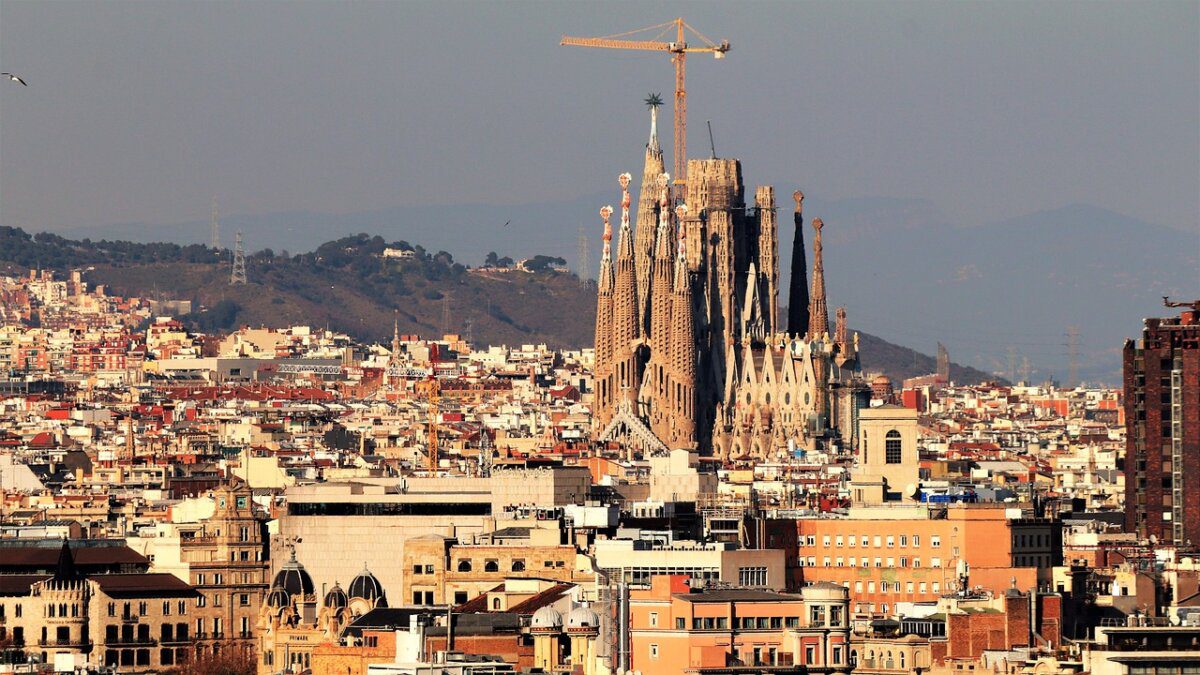When you think of places to see in Barcelona, it’s Gaudí’s imaginative architecture that first comes to mind.
Yet, it’s Picasso’s words that truly capture the city’s essence:
There is where it all began… There is where I understood how far I could go.
Pablo Picasso
This vibrant city, where Gothic spires stand beside modernist marvels, embodies this spirit of discovery.
As you wander from the whimsical Park Güell to the bustling streets of La Rambla, each step is an invitation to explore and grow.
Barcelona is a tapestry woven with tradition, innovation, and the warmth of the Mediterranean.
It’s a place where history and the future coexist, inspiring you to see how far you can go.
In this city, Picasso’s reflection isn’t just a memory of the past; it becomes a motto for every traveler seeking their own Barcelona story.
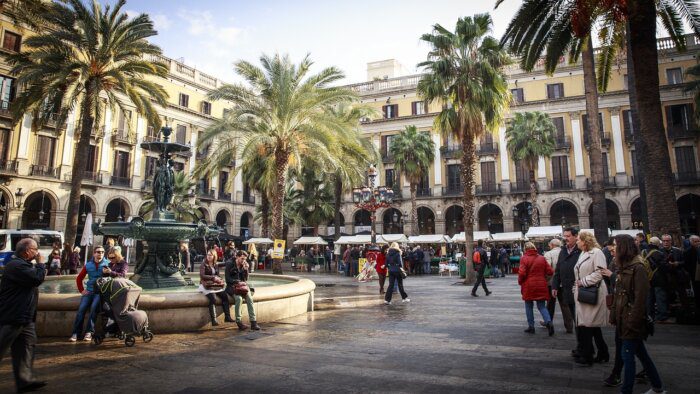
My list of places to see in Barcelona
Here’s my list of ten unmissable places to see in Barcelona (in alphabetical order).
The Barceloneta Beach
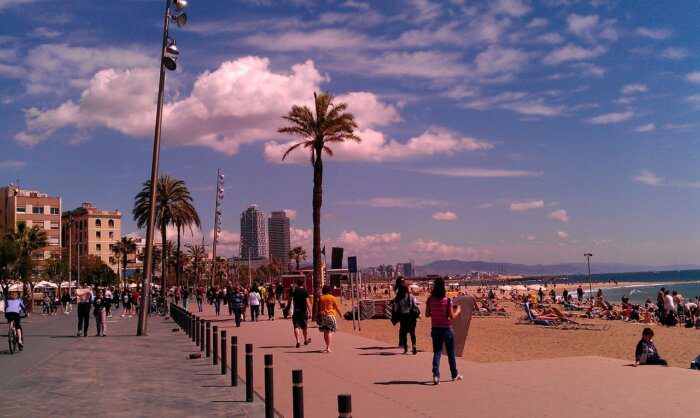
Did you know…?
The Barceloneta Beach, known for its golden sands, hides a secret. It’s man-made, created for the 1992 Olympics.
Before then, Barcelona’s coastline lacked real beaches. Today, it’s a bustling hub of relaxation and culture, a transformation from its industrial past.
This beach is not just a spot for sunbathing; it’s a proof of Barcelona’s reinvention and adaptability.
Here, history and modern leisure converge, offering a unique seaside experience in the heart of the city.
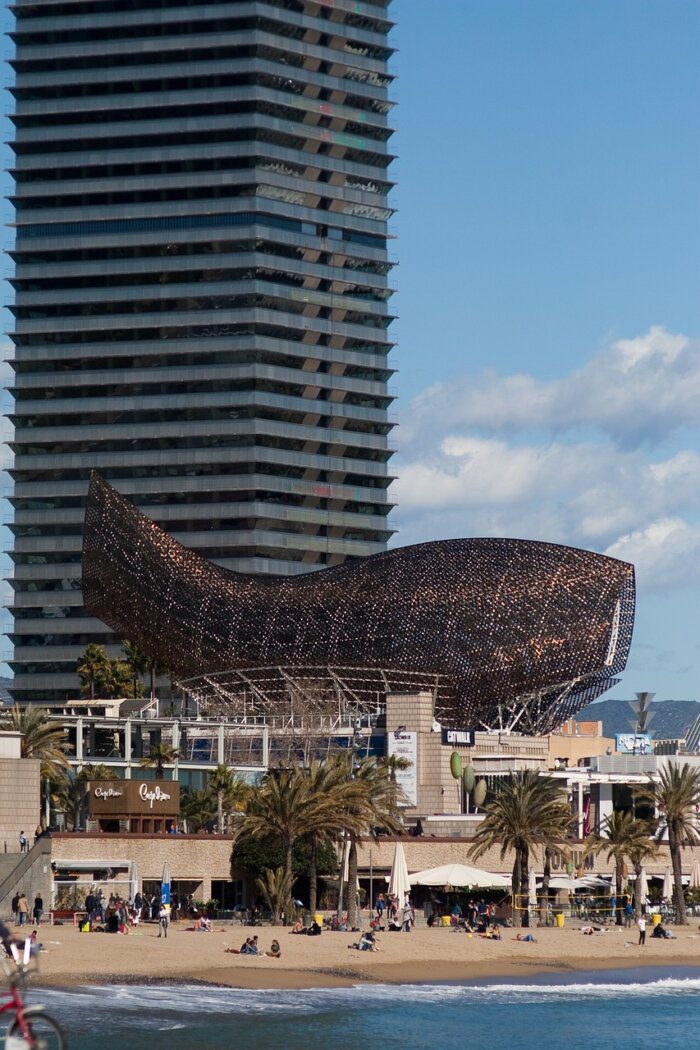
What is the Barceloneta Beach and why see it?
The Barceloneta Beach is a vibrant oasis. Stretching along the Mediterranean, it’s famed for its shimmering sands and azure waters.
This beach isn’t just for soaking in sunshine; it’s a lively social scene. Here, locals and tourists mingle, playing beach sports and enjoying seaside strolls.
Charming chiringuitos (beach bars) dot the coastline, offering refreshments with a view. Its picturesque promenade, lined with palm trees, is perfect for a leisurely bike ride or a sunset walk.
The Barceloneta Beach is more than a beach; it’s a slice of Barcelona’s dynamic lifestyle, where the city’s energy meets the tranquility of the sea.
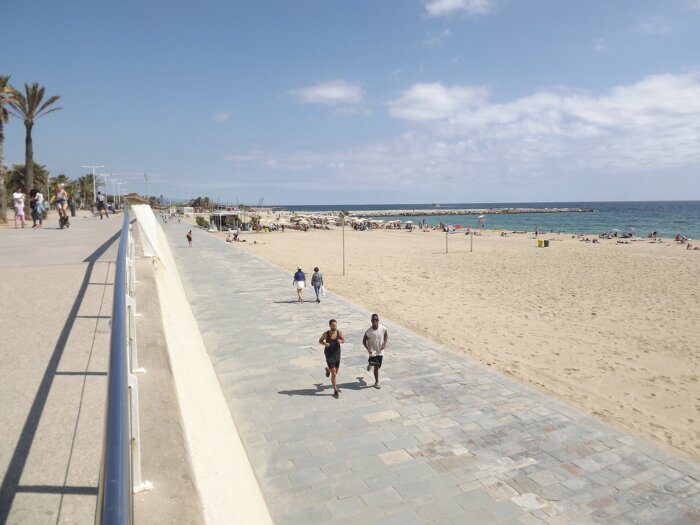
How to enjoy the Barceloneta Beach?
Reaching The Barceloneta Beach is straightforward, whether you prefer walking or public transport.
From the city center, a scenic 20 to 30-minute walk through areas like the Gothic Quarter or El Born offers a glimpse into Barcelona’s vibrant street life.
Alternatively, take the metro to Barceloneta or Ciutadella-Vila Olímpica stations, or choose a bus for convenience.
The beach is popular, especially in summer, so arriving early helps secure a good spot.
To enhance your experience, explore the picturesque promenade, savor refreshments at local chiringuitos, and don’t forget sunscreen and possibly an umbrella rental.
The Camp Nou Stadium
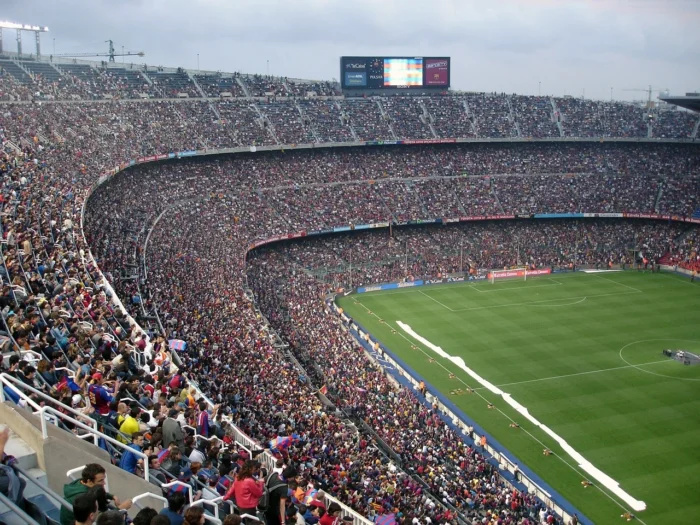
Did you know…?
Camp Nou, famous for its football fervor, holds a less-known record. It’s the largest stadium in Europe by capacity, a fact often overshadowed by its sporting legends. This architectural giant can host an astounding 99,354 spectators.
Uniquely, it was funded by fans in the 1950s, a gesture of their passion and dedication. This community-driven origin story is a source of pride for locals and fans alike.
It’s not just a stadium; it’s a symbol of the unifying power of football in Barcelona, built and sustained by the love and loyalty of its supporters.

What is Camp Nou and why see it?
Camp Nou, home to FC Barcelona, is more than a stadium; it’s a footballing sanctuary.
Here, the spirit of football is palpable, steeped in the triumphs and passions of one of the world’s most celebrated clubs.
Visitors can experience the exhilarating atmosphere on match days or explore its rich history through the Camp Nou Experience tour, including the museum and the iconic pitch.
The stadium’s grandeur and the fervent energy of its fans make it a must-visit for sports enthusiasts.
It’s not just a ground for football; it’s a symbol of Catalan pride and a testament to the sport’s unifying power.
How to enjoy Camp Nou?
Getting to Camp Nou is easy via public transport. Take the metro to Les Corts, Maria Cristina, or Palau Reial stations.
On match days, arrive early to avoid crowds.
Book your Camp Nou Experience tour in advance, especially during peak season.
Keep in mind, during games, the atmosphere is electrifying but also very crowded. For a quieter experience, choose a non-match day. This way, you’ll fully appreciate this iconic stadium and its rich football heritage.
More information: Camp Nou website
Casa Batlló and Casa Milà
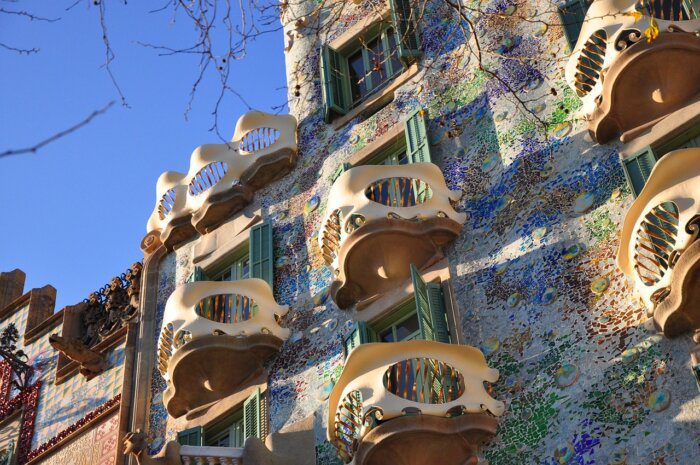
Did you know…?
Casa Batlló and Casa Milà, two of Gaudí’s masterpieces, share a secret beneath their famous façades.
These buildings are not just architectural wonders but also early examples of ergonomic design.
Gaudí’s focus on natural forms resulted in features like curved wooden door handles, shaped perfectly to fit the human hand.
This attention to human comfort, uncommon in early 20th-century architecture, makes these buildings not only visually stunning but also uniquely user-friendly.
These details reveal Gaudí’s vision of blending form with function, adding another layer to the appreciation of his work.
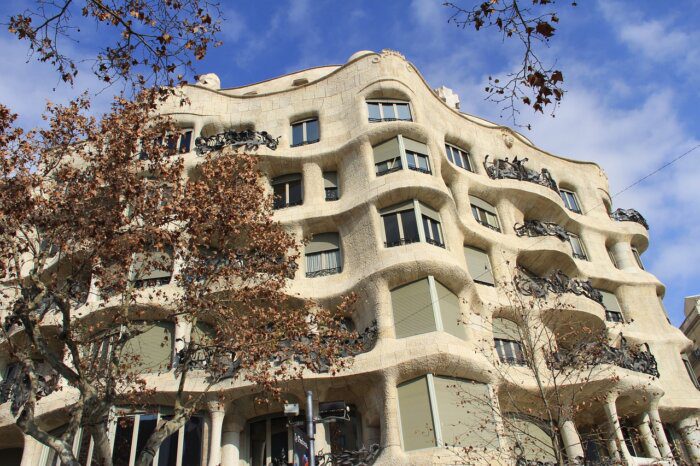
What are Casa Batlló and Casa Milà and why see them?
Casa Batlló and Casa Milà, two jewels in Barcelona’s architectural crown, are masterpieces by Antoni Gaudí.
Casa Batlló, with its vibrant, dragon-like façade, showcases Gaudí’s unique take on Modernisme.
Inside, its organic shapes and light-filled spaces create an almost magical atmosphere.
Nearby, Casa Milà, also known as La Pedrera, stands out with its undulating stone exterior and iconic chimney pots.
Its rooftop offers stunning views of the city and a closer look at Gaudí’s innovative design.
Both buildings are UNESCO World Heritage Sites, celebrated for their artistic and architectural innovation.
Visiting them offers a glimpse into Gaudí’s genius, where art and architecture fuse in extraordinary ways.
These are not just buildings; they’re embodiments of Barcelona’s creative spirit.
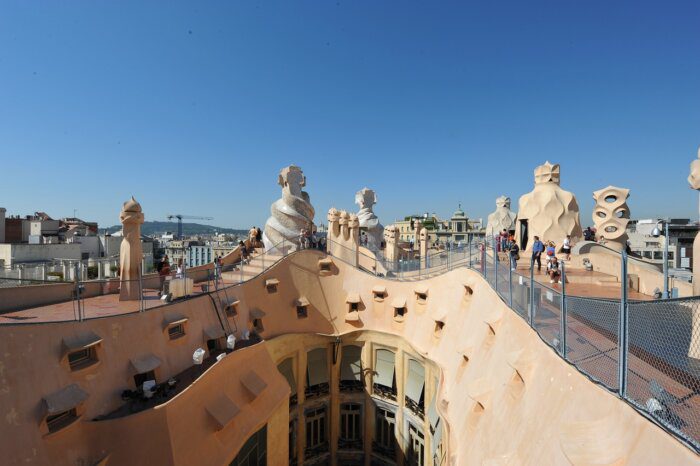
How to enjoy Casa Batlló and Casa Milà?
Casa Batlló and Casa Milà are easily accessible by metro, with Passeig de Gràcia station just a short walk away.
To fully appreciate these Gaudí masterpieces, book tickets online in advance, especially during peak tourist season. Consider guided tours for in-depth insights.
Remember, both buildings can get crowded, so visiting early or late in the day is advisable for a more relaxed experience.
Don’t rush; take time to absorb the intricate details and unique design elements that make these sites so special.
More information: Casa Batlló website, Casa Milà website.
Gothic Quarter
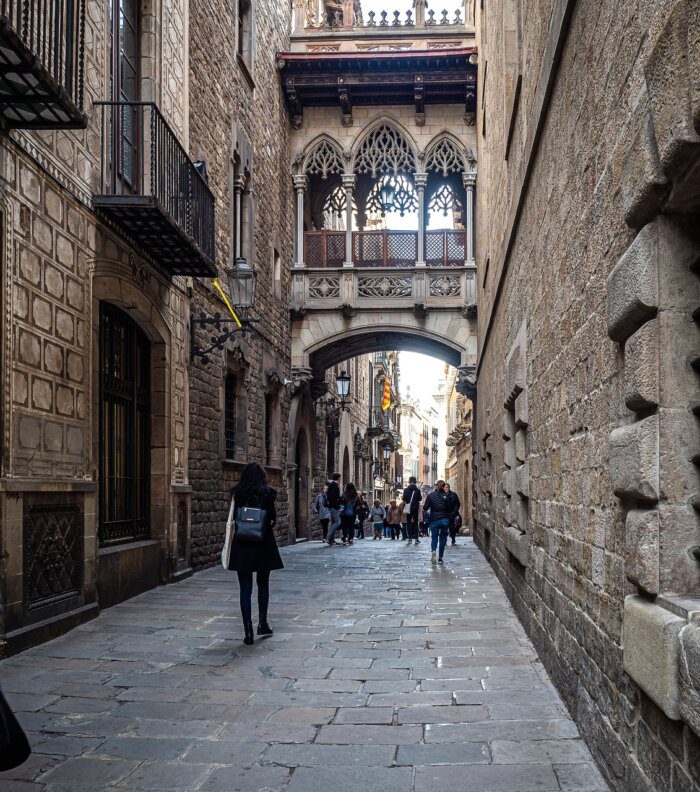
Did you know…?
Barcelona’s Gothic Quarter, with its ancient streets, hides a unique feature: Roman ruins beneath the cityscape.
These remnants of ancient Barcino, including parts of the old Roman wall and aqueduct, are integrated into the foundations of more modern buildings.
This layered history is visible in places like the Plaça del Rei, where the medieval royal palace sits atop Roman ruins.
Exploring the Gothic Quarter offers a rare opportunity to traverse multiple eras in just a few steps, a journey through time that adds a hidden depth to this historic area.
This blend of ancient and medieval elements is a sign of Barcelona’s rich and multifaceted heritage.
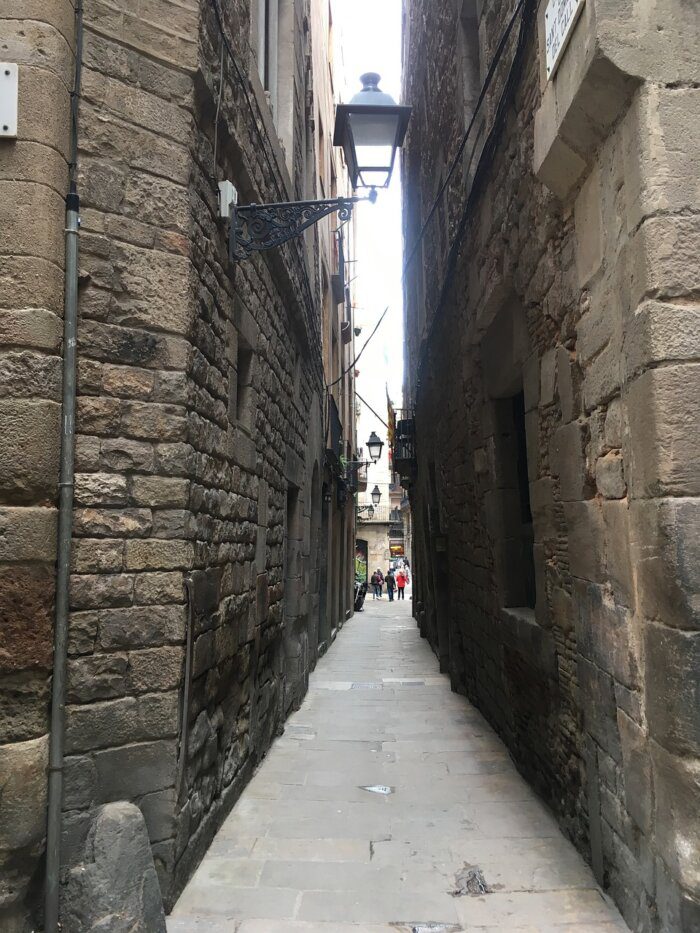
What is Gothic Quarter and why see it?
The Gothic Quarter is the historic heart of Barcelona, a labyrinth of narrow streets and medieval buildings.
This area, with its mix of Roman and medieval architecture, is like a time capsule of the city’s past.
Notable landmarks include the Barcelona Cathedral, with its stunning Gothic façade, and the picturesque squares like Plaça del Rei and Plaça Sant Jaume.
The Quarter’s charm lies in its hidden gems: secluded courtyards, antique shops, and traditional bars tucked away in its alleys.
At night, the streets come alive with a vibrant atmosphere, making it a perfect blend of history and contemporary culture.
The Gothic Quarter isn’t just a tourist attraction; it’s a living, breathing part of Barcelona’s soul, offering a unique journey through centuries of history.
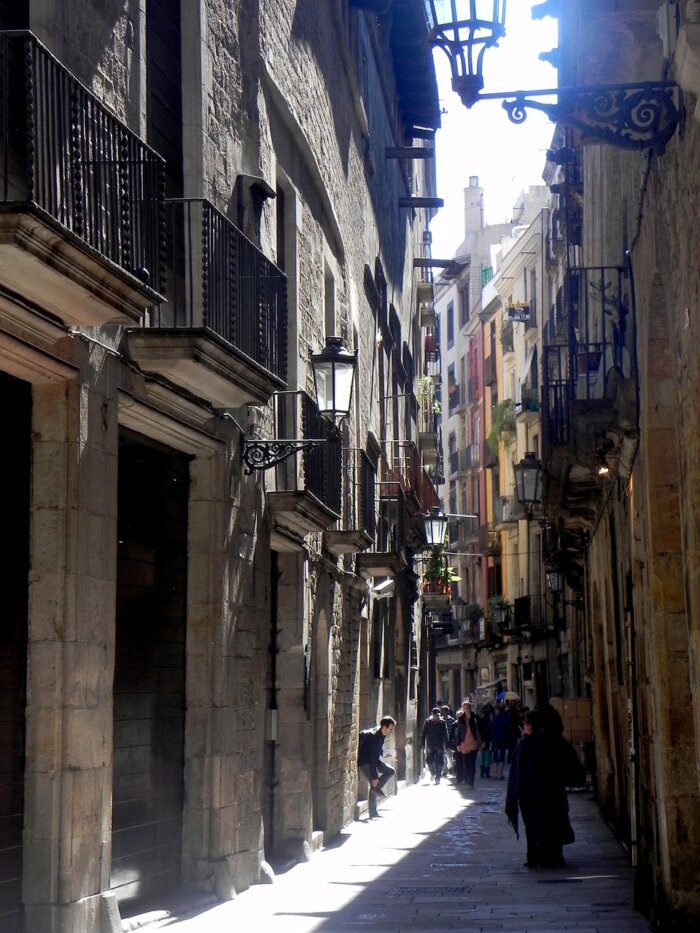
How to enjoy Gothic Quarter?
The Gothic Quarter is nestled in the center of Barcelona, easily reached by the Jaume I or Liceu metro stations.
Wander its streets on foot to fully immerse in its charm.
It’s best explored without a strict itinerary; let curiosity guide you.
Be mindful of narrow, crowded alleys and keep personal belongings secure.
Visit landmarks early to avoid crowds.
Don’t miss hidden courtyards and local shops for an authentic experience.
Respect the residential nature of the area and enjoy the blend of history and modern life.
This approach lets you fully appreciate the Quarter’s timeless allure.
La Rambla
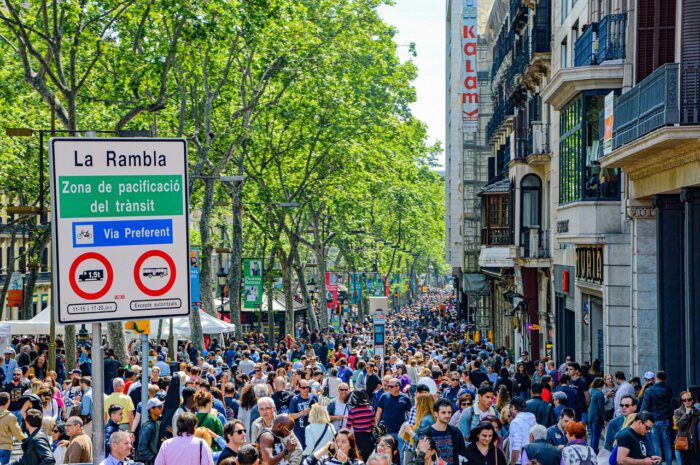
Did you know…?
La Rambla, Barcelona’s famous boulevard, was once a flowing river.
This bustling street, now lined with shops and cafes, followed the course of a seasonal stream that flowed outside the city walls.
Over time, as Barcelona expanded, the riverbed was paved over, transforming into the vibrant promenade we see today.
This transformation from a natural waterway to a lively urban center is a unique aspect of La Rambla’s history, often unknown to many visitors.
It adds an intriguing layer to the experience of walking down this iconic street, blending Barcelona’s natural and urban histories.
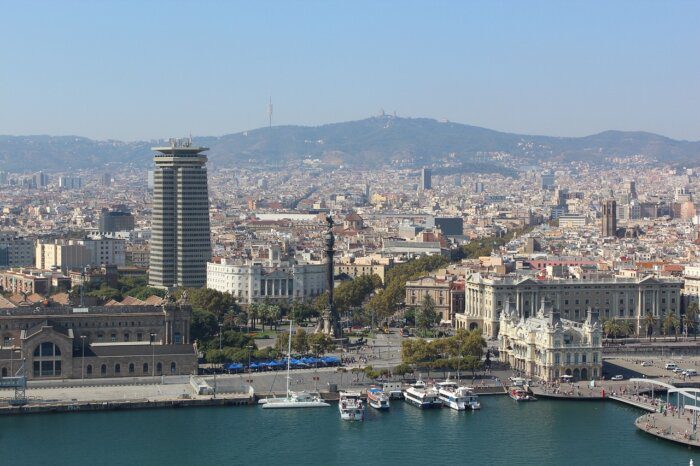
What is La Rambla and why see it?
La Rambla is a bustling 1.2-kilometer boulevard, the pulsating heart of Barcelona.
Stretching from Plaça de Catalunya to the waterfront, it’s a mosaic of street performers, local artists, and flower stalls.
Lined with historic buildings, cafes, and markets, including the famous La Boqueria, it offers a vibrant slice of Catalan life.
La Rambla is special for its lively atmosphere, where tourists and locals alike converge. Its energy is infectious, making it a perfect place for a leisurely stroll, people-watching, and soaking in the city’s dynamic spirit.
This street embodies the essence of Barcelona – a blend of tradition, culture, and urban vibrancy, making it a must-visit for anyone exploring the city.
How to enjoy La Rambla?
La Rambla runs through the heart of Barcelona, easily accessible from the Catalunya, Liceu, or Drassanes metro stations.
To fully experience its charm, walk along its length.
Be aware that it’s often crowded and a hotspot for pickpockets, so keep your belongings secure.
The best times to visit are morning or late afternoon, when it’s less crowded.
Engage with street performers and visit La Boqueria market.
Remember, La Rambla is best experienced at a leisurely pace, allowing you to absorb the vibrant atmosphere and diverse offerings of this iconic Barcelona street.
Montjuïc Hill
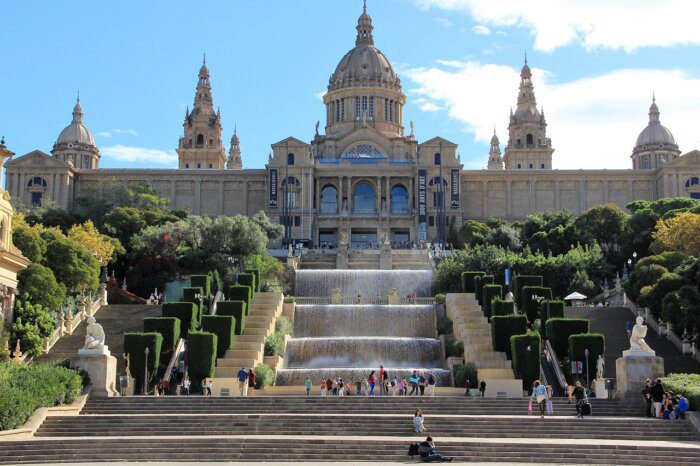
Did you know…?
Montjuïc Hill, known for its panoramic views of Barcelona, holds a secret garden, the Mossèn Costa i Llobera Gardens.
This lesser-known spot is one of Europe’s foremost cactus gardens, boasting an impressive collection of cacti and succulents from around the world.
Tucked away on the southeastern slopes of Montjuïc, these gardens offer a unique, tranquil escape from the city’s hustle and bustle.
With over 800 species, it’s a paradise for plant enthusiasts and a hidden gem for visitors.
The juxtaposition of exotic plants against the backdrop of the city and sea makes this garden a surprising and serene retreat, adding another layer to the diverse experiences Montjuïc Hill offers.
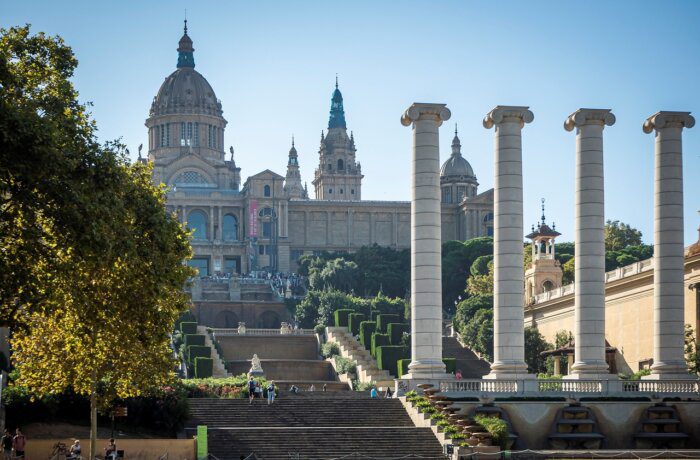
What is Montjuïc Hill and why see it?
Montjuïc Hill, a lush green oasis in Barcelona, offers more than just stunning city views.
It’s a cultural treasure trove, home to the Magic Fountain, the National Art Museum of Catalonia, and the Joan Miró Foundation.
The hill also played a significant role in the 1992 Olympics, with facilities still used for sporting events.
Its botanical gardens provide a peaceful retreat, while the historic Montjuïc Castle at the summit adds historical intrigue.
The hill’s diverse attractions, from art to nature, make it a must-visit, offering something for everyone.
Its mix of natural beauty, cultural richness, and historical significance makes Montjuïc a unique and memorable part of any Barcelona itinerary.
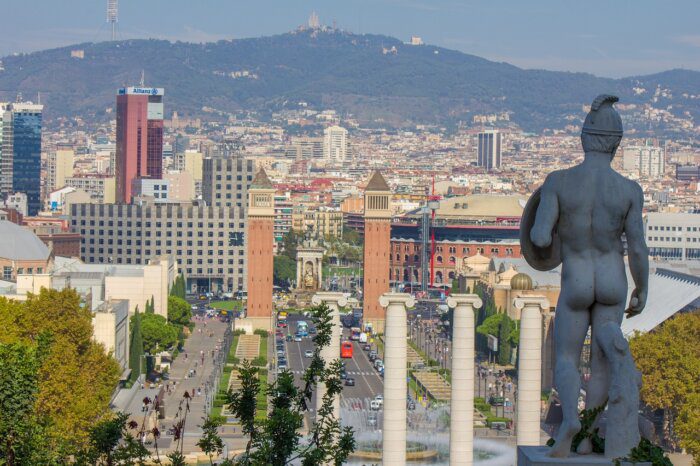
How to enjoy Montjuïc Hill?
To reach Montjuïc Hill, start by taking the metro to Espanya station.
From there, you have two scenic options: the Montjuïc Funicular, which connects to the metro station, or the Montjuïc Cable Car.
The funicular offers a direct route partway up the hill, from where you can walk or catch a bus to the top.
For a more panoramic experience, take a short walk from the funicular station to the Telefèric de Montjuïc, where the cable car offers stunning aerial views of the city and sea.
Wear comfortable shoes for exploring the hill’s attractions, and be aware of the varying operating hours and entry fees.
Combining the metro, funicular, and cable car provides a full experience of Montjuïc’s natural beauty and ease of access, making your visit both enjoyable and efficient.
More information: Montjuïc Castle website, Telefèric de Montjuïc website.
Palau de la Música Catalana
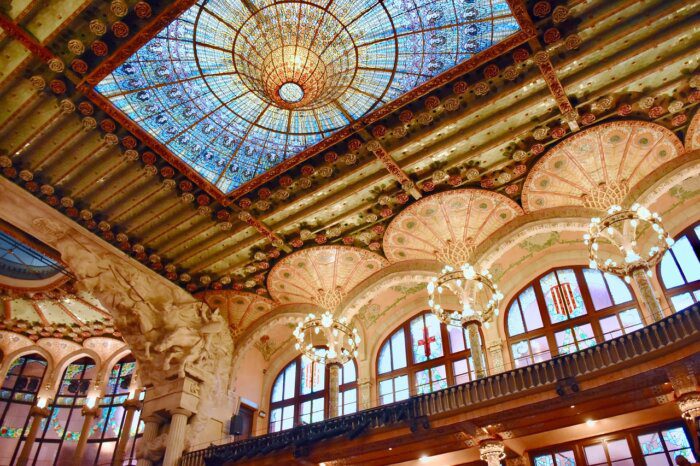
Did you know…?
The Palau de la Música Catalana, a jewel of Catalan modernism, has a unique feature: it’s illuminated entirely by natural light during the day.
The architect, Lluís Domènech i Montaner, ingeniously designed the stained glass windows and the stunning inverted dome skylight to flood the concert hall with daylight.
This architectural marvel creates a magical ambiance, enhancing the acoustics and visual beauty of performances.
This emphasis on natural light was revolutionary for its time and remains a distinctive aspect of the Palau, setting it apart from other concert halls around the world.
This blend of functionality and aesthetics underscores the innovative spirit that defines much of Barcelona’s architectural heritage.
What is Palau de la Música Catalana and why see it?
The Palau de la Música Catalana, a UNESCO World Heritage Site, is an architectural masterpiece of Catalan modernism.
It stands out with its elaborate façade, adorned with mosaics, sculptures, and intricate ironwork. Inside, the concert hall is a symphony of color, highlighted by a spectacular stained glass skylight.
Renowned for its exceptional acoustics, the Palau hosts a wide range of musical performances, making it a haven for music lovers.
The building’s interior is equally stunning, with a lavish use of ceramic tiles, ornate sculptures, and rich details that embody the artistic spirit of Barcelona.
Visiting the Palau offers not just a musical experience, but an immersion into an extraordinary work of art, reflecting the city’s deep cultural and artistic heritage.
How to enjoy Palau de la Música Catalana?
The Palau de la Música Catalana is located in Barcelona’s Sant Pere neighborhood, easily reached by the Urquinaona metro station.
Once there, consider joining a guided tour to fully appreciate its architectural and historical significance.
Book tickets in advance, especially for concerts, as they can sell out quickly.
Inside, photography is allowed, but without flash, to preserve the art and ambiance.
Be mindful of the concert hall’s etiquette if attending a performance. The Palau’s intricate details and acoustics are best enjoyed in a quiet, respectful atmosphere.
This approach ensures a rich experience, blending musical enjoyment with architectural admiration in one of Barcelona’s most iconic buildings.
More information: Palau de la Música Catalana website
Park Güell
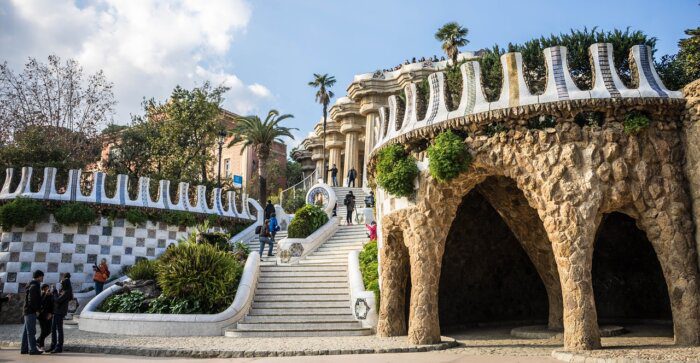
Did you know…?
Park Güell, renowned for its Gaudí-designed landscapes, hides a lesser-known fact: it was originally conceived as a residential housing project.
The vision was to create a garden city blending nature with living spaces.
However, only two houses were built before the project was abandoned due to lack of interest.
This unexpected turn of events led to the creation of the public park we see today.
Gaudí himself lived in one of the houses, now a museum dedicated to his life and work.
This shift from private estate to public park adds a fascinating layer to Park Güell’s history, revealing Gaudí’s innovative ideas about urban living and the integration of natural landscapes into architectural design.
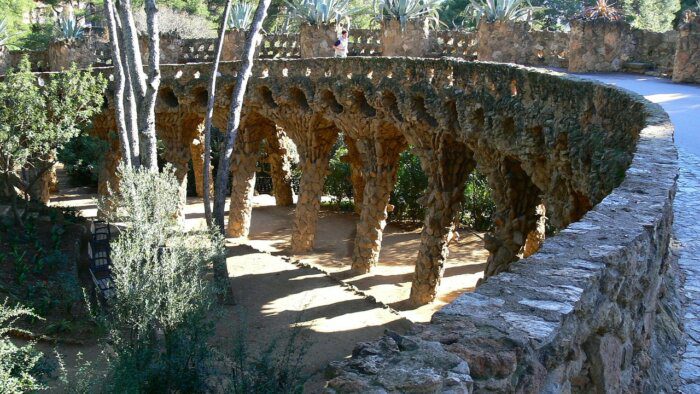
What is Park Güell and why see it?
Park Güell, one of Barcelona’s most enchanting landmarks, is a public park and a UNESCO World Heritage Site
It showcases Gaudí’s unique architectural style, blending natural forms with vibrant mosaics and whimsical structures.
The park features the famous serpentine bench, the colorful dragon fountain, and winding pathways that offer stunning views of Barcelona.
The Sala Hipóstila, with its 86 Doric columns, and the nature-inspired viaducts add to its allure.
Park Güell is not just a park; it’s an artistic wonderland that reflects Gaudí’s vision of integrating architecture with the natural environment.
Its playful design, panoramic city views, and artistic brilliance make it a must-visit destination, capturing the imaginative spirit of Barcelona.
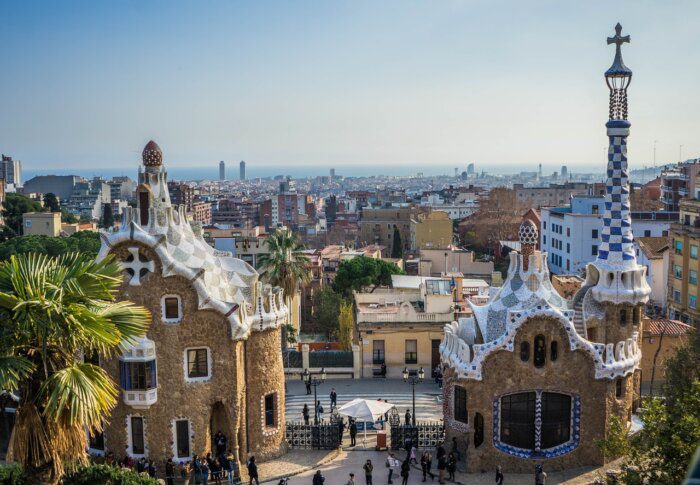
How to enjoy Park Güell?
Park Güell is situated in Barcelona’s Gràcia district, accessible by the Lesseps or Vallcarca metro stations, followed by a walk with some uphill stretches.
Consider using the bus service, which offers a more direct route to the park’s entrance.
Comfortable walking shoes are a must, as the park’s terrain is varied and expansive.
Be prepared for the weather, bringing sunscreen or a hat for sunny days.
While exploring, take time to enjoy the panoramic views and artistic details.
Remember, Park Güell is a popular tourist attraction, so visiting early in the day or during off-peak seasons can offer a more tranquil experience.
More information: Park Güell website
Picasso Museum
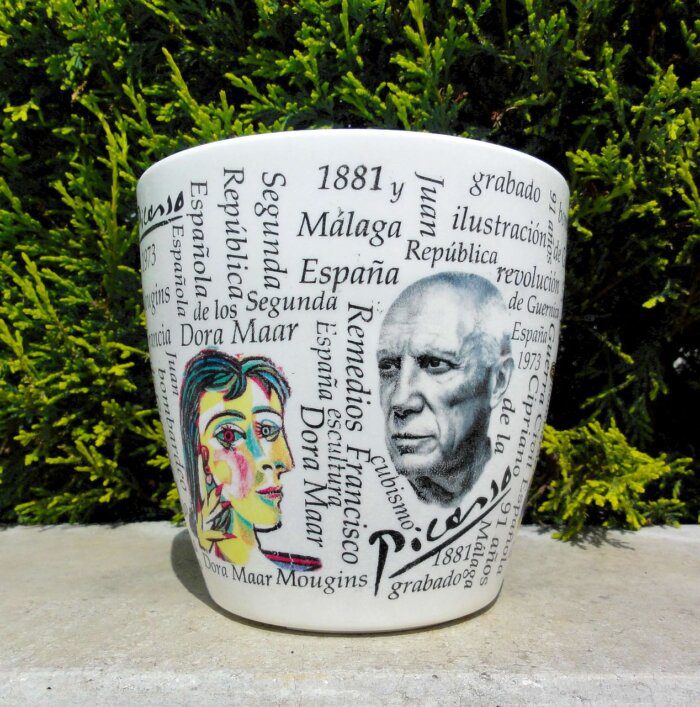
Did you know…?
The Picasso Museum in Barcelona not only showcases the artist’s work but also reveals a personal connection: it was established during Picasso’s lifetime.
The artist himself was involved in its creation, choosing many of the initial works to be displayed.
This direct involvement makes the museum unique, as it reflects Picasso’s own vision of his career’s journey.
Located in the La Ribera neighborhood, the museum also highlights the artist’s deep bond with Barcelona, a city that played a pivotal role in his formative years.
This intimate link between the artist and the museum offers visitors a rare glimpse into Picasso’s early artistic development and his lasting relationship with the city.
What is Picasso Museum and why see it?
The Picasso Museum in Barcelona is a tribute to Pablo Picasso’s profound connection with the city.
Housed in five medieval stone mansions, the museum boasts one of the most extensive collections of Picasso’s early works.
It uniquely chronicles his formative years, offering insight into his artistic evolution.
Specializing in his pre-Cubist period, the museum features famous works like ‘The First Communion’ and ‘Science and Charity.’
Its setting in historic buildings adds to the charm, allowing visitors to step back in time while exploring Picasso’s journey.
The museum’s intimate atmosphere and focused collection make it special, providing a deeper understanding of one of the 20th century’s most influential artists.
It’s a must-visit for art lovers and those seeking to understand Picasso’s early artistic endeavors and his enduring bond with Barcelona.
How to enjoy Picasso Museum?
The Picasso Museum is located in Barcelona’s La Ribera neighborhood, easily accessible via the Jaume I or Arc de Triomf metro stations.
Upon arrival, it’s advisable to have pre-booked tickets, especially during peak tourist seasons, to avoid long queues.
The museum offers audio guides, enhancing the experience with detailed insights into Picasso’s works and life.
Photography is permitted without flash, allowing visitors to capture memories while preserving the art.
Be mindful of the museum’s varied temporary exhibitions, which can offer new perspectives on Picasso’s work.
Visiting on the first Sunday of the month can be budget-friendly, as entry is free, but also busier.
This mindful approach ensures a fulfilling visit, deepening your appreciation of Picasso’s legacy in the city he loved.
More information: Picasso Museum website
Sagrada Família
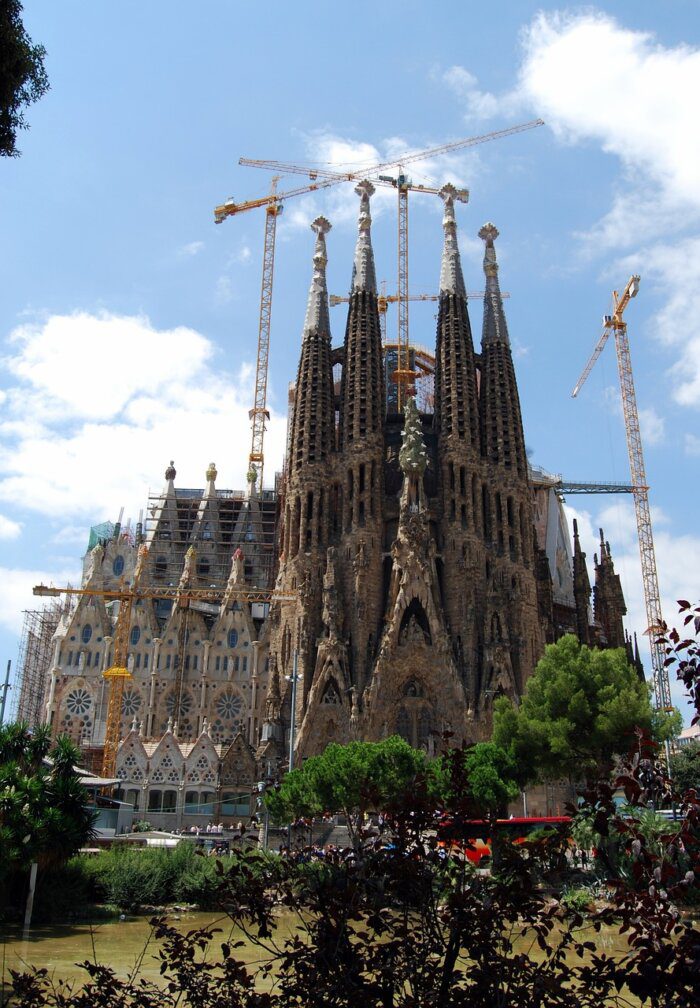
Did you know…?
A lesser-known fact about the Sagrada Familia is its unique integration of nature into its design.
Antoni Gaudí, the architect, was deeply influenced by natural forms, which is evident in the structure’s details.
The columns inside the basilica are designed to resemble trees and branches, creating a forest-like atmosphere.
This design not only serves an aesthetic purpose but also a structural one, as the branching columns support the massive ceiling.
Gaudí’s innovative use of nature-inspired forms makes the Sagrada Familia a masterpiece where architecture and the natural world seamlessly converge.
This incorporation of organic elements into the building’s design is not just visually stunning but also an embodiment of Gaudí’s vision of harmonizing architecture with nature.
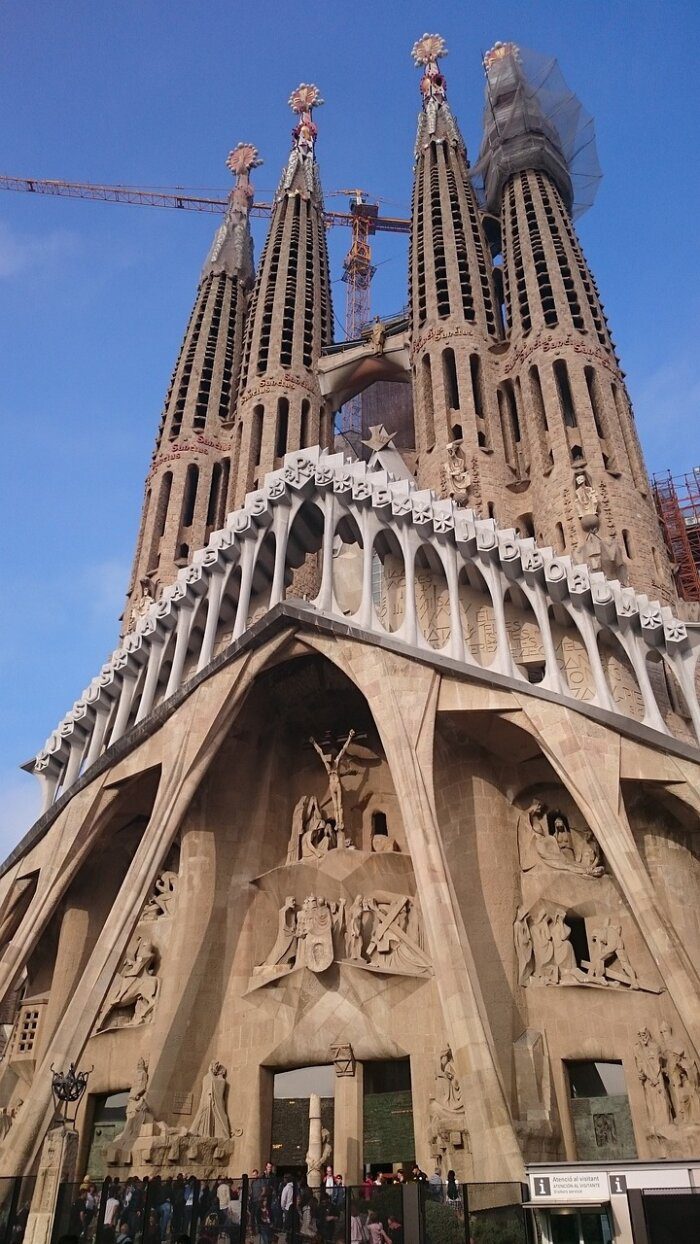
What is Sagrada Família and why see it?
The Sagrada Familia is an iconic symbol of Barcelona, a monumental basilica designed by the visionary architect Antoni Gaudí.
Its construction began in 1882 and continues to this day, a testament to Gaudí’s ambitious and ever-evolving design.
This architectural marvel is renowned for its towering spires, intricate facades depicting biblical scenes, and the stunning play of light within its interiors.
The basilica combines Gothic and Art Nouveau forms, creating a unique and awe-inspiring experience for visitors.
The Sagrada Familia is not just a church; it’s a piece of living history and an embodiment of Gaudí’s innovative approach to architecture, making it a must-visit landmark for anyone traveling to Barcelona.
Its ongoing construction, funded by visitor tickets and donations, adds to its allure as a project of the people, for the people.
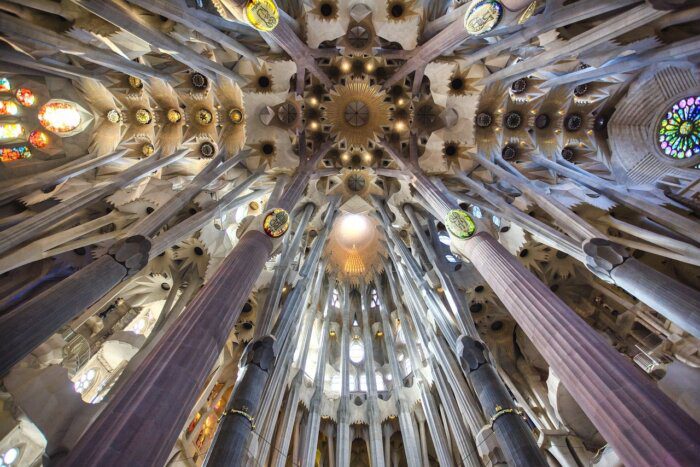
How to enjoy Sagrada Família?
The Sagrada Familia is centrally located in Barcelona, easily accessible via the Sagrada Familia metro station on lines L2 and L5.
Pre-booking tickets online is highly recommended to avoid long lines and ensure entry.
Photography is allowed, but tripods are not, to maintain a smooth flow of visitors.
Comfortable footwear is advisable, as exploring the basilica and its towers involves a fair amount of walking and stair-climbing.
Audio guides are available for a more enriching experience, providing insights into Gaudí’s masterpiece.
Be aware of the ongoing construction, which is part of the basilica’s unique charm.
With these tips in mind, visitors can fully appreciate the architectural brilliance and spiritual ambiance of this iconic Barcelona landmark.
More information: Sagrada Família website
Conclusion
As our journey through places to see in Barcelona comes to a close, we’re left with a mosaic of unforgettable experiences.
From the lively sands of the Barceloneta Beach to the awe-inspiring Sagrada Familia, each site we’ve explored tells a unique story of art, history, and innovation.
Barcelona is more than just a city; it’s a living canvas where every street, building, and beach paints a picture of vibrant culture and architectural genius.
Whether marveling at the Gothic Quarter’s historic charm, strolling in the Park Güell, or experiencing the grandeur of Camp Nou, Barcelona leaves an indelible mark on its visitors.
It’s a city where each visit reveals something new, a place where the spirit of Gaudí, Picasso, and the Mediterranean merges to create an experience that is truly one of a kind.
As we bid farewell to Barcelona, we carry with us memories of a city that continually stretches the horizons of what is possible, inviting us back to discover even more.
“There is where it all began… There is where I understood how far I could go.”
Happy travel
Marcin
My top places to see in Barcelona
- The Barceloneta Beach
- The Camp Nou Stadium
- Casa Batlló and Casa Milà
- The Gothic Quarter
- La Rambla
- Montjuïc Hill
- Palau de la Música Catalana
- Park Güell
- The Picasso Museum
- Sagrada Família
Useful links
Barcelona Public Transportation website
Looking for more inspiration for places to visit?
The Best Of Europe: Top 10 Iconic Cities To Visit?
The Best Of North America: Your Ultimate Guide To 10 Most Vibrant Cities?

